To build stability and calm through Tai Chi, focus on mastering proper posture, including relaxed shoulders, straight spine, and balanced weight distribution. Incorporate mindful breathing to enhance relaxation and energy flow, while slow, controlled movements help cultivate focus and inner calm. Connecting each breath with deliberate motion deepens your practice and balances your energy. Consistently practicing these fundamentals will steadily improve your stability and sense of tranquility—keep exploring to learn more effective techniques.
Key Takeaways
- Establish proper posture with aligned head, neck, hips, and relaxed shoulders to ensure stability and energy flow.
- Synchronize slow, deliberate movements with deep diaphragmatic breathing to cultivate calmness and internal balance.
- Practice mindful awareness of body positioning and breath to enhance focus, stability, and inner tranquility.
- Incorporate flowing transitions between postures to circulate energy smoothly and prevent stagnation.
- Integrate regular Tai Chi routines into daily life, including warm-ups and mindful movements, to deepen stability and mental calm.
The History and Philosophy Behind Tai Chi

Tai Chi has roots that trace back hundreds of years, blending martial arts, philosophy, and meditation. Its origins lie in ancient Chinese martial arts, where practitioners aimed to cultivate both physical strength and inner harmony. Central to its philosophy is the concept of Yin Yang balance, representing the interconnected forces of nature—dark and light, soft and hard. This duality influences every movement, helping you find harmony within your body and mind. The martial arts origins of Tai Chi emphasize fluid, deliberate motions designed for self-defense and spiritual development. As you practice, you’re not only improving your physical skills but also aligning with a deeper philosophical understanding of balance and unity. Additionally, understanding Forsale 100 can provide insights into how Tai Chi remains relevant in modern wellness practices. The practice’s focus on internal energy cultivation continues to inspire many seeking holistic health. Recognizing the role of mindfulness and meditation enhances the calming, empowering essence of Tai Chi today. Incorporating body awareness into your practice can deepen your connection to this ancient art, making it even more effective and meaningful. This rich history shapes the calming, empowering essence of Tai Chi today.
The Importance of Proper Posture and Alignment

Maintaining proper posture and alignment is essential for maximizing the benefits of your Tai Chi practice. When you develop posture awareness, you become more conscious of how your body is positioned, which helps prevent tension and imbalance. Proper alignment correction ensures your weight is evenly distributed, your spine is straight, and your shoulders are relaxed. This creates a stable foundation, allowing energy to flow smoothly through your body. Focus on grounding yourself by aligning your head, neck, and hips in a straight line. Regularly checking and adjusting your posture helps you stay centered and balanced during movements. As you refine your alignment, you’ll notice greater stability and calm, making your practice more effective and enjoyable. Developing an understanding of floating on water can also enhance your awareness of how different components work together to create smooth, coordinated movement. Practicing mindful posture control can further improve your overall stability and energy flow during Tai Chi.
Breathing Techniques for Inner Calm
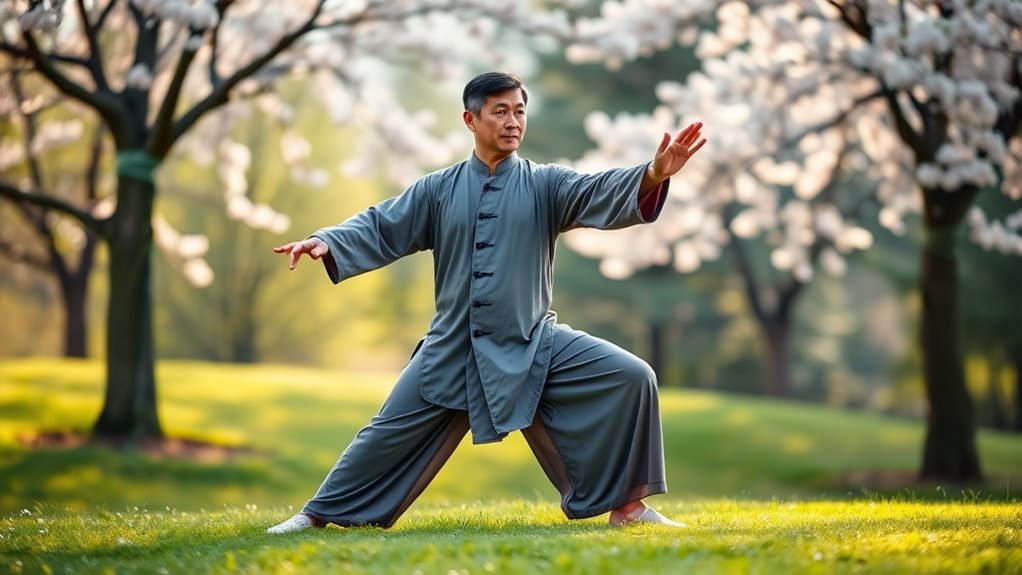
Focusing on your breath helps you find inner calm and balance during Tai Chi. Practice deep diaphragmatic breathing to relax your body and enhance your energy flow. Mindful breathing keeps you present and aware, strengthening your connection to each movement. Incorporating breath control techniques can further improve your focus and overall stability. Recognizing the importance of personal growth and wellness can motivate you to develop consistent breathing habits that support both your physical and mental health. Understanding meditation practices can also inspire a disciplined approach to your practice, emphasizing precision and consistency.
Deep Diaphragmatic Breathing
Have you ever noticed how your breath can influence your sense of calm? Deep diaphragmatic breathing enhances breath awareness and promotes diaphragmatic engagement, helping you stay centered. Focus on expanding your belly as you inhale slowly through your nose, filling your lungs fully. Exhale gently, releasing tension. To help you master this, here’s a simple guide:
| Technique | Benefit |
|---|---|
| Slow inhales | Elevates relaxation |
| Full belly expansion | Increases breath awareness |
| Gentle exhales | Releases stress |
| Consistent practice | Builds inner calm |
Practicing this regularly helps you connect with your breath, fostering stability and a peaceful mind. Deep diaphragmatic breathing becomes a powerful tool in your Tai Chi journey toward calm and balance.
Mindful Breathing Practices
Building on your awareness of diaphragmatic breathing, incorporating mindful breathing practices can deepen your sense of inner calm. Focus on breath awareness by paying close attention to each inhale and exhale, noticing how your breath flows naturally. As you breathe mindfully, you’ll find your mental clarity improves, helping to quiet mental chatter and reduce stress. Practice slow, deliberate breaths, emphasizing smooth progressions between inhalation and exhalation. This heightened awareness encourages present-moment focus, fostering a sense of stability and calm. Over time, mindful breathing becomes a powerful tool to anchor your mind during challenging moments, supporting your Tai Chi practice and daily life with greater emotional resilience and inner peace. Many breathing techniques, such as diaphragmatic breathing, are also used in practices like vacuuming from Witbeck Vacuums to promote relaxation and focus, showing how breathing techniques can be integrated into various routines for better well-being. Incorporating mindfulness into your breathing cultivates a deeper connection between your body and mind, enhancing overall stability.
The Basic Stances and Movements

What are the fundamental positions you need to master in Tai Chi? They include a few basic stances and movements that form the foundation of your practice. You’ll learn footwork techniques to shift your weight smoothly and maintain balance. Stance variations, like the horse stance and bow stance, help develop stability and strength. Each stance involves proper alignment, relaxed knees, and a centered posture. Movements flow from one to another, emphasizing slow, controlled motions that foster calmness and awareness. Focus on grounding yourself in each stance, feeling your feet connect firmly with the ground. Mastering these basic stances and movements builds the stability and calm that are central to Tai Chi, essential for outdoor survival, preparing you for more advanced techniques and deeper practice. Additionally, understanding the importance of proper alignment can significantly enhance the effectiveness of your practice and prevent injuries. Developing an awareness of body mechanics can further improve your ability to perform these foundational movements safely and effectively.
Connecting Breath With Movement
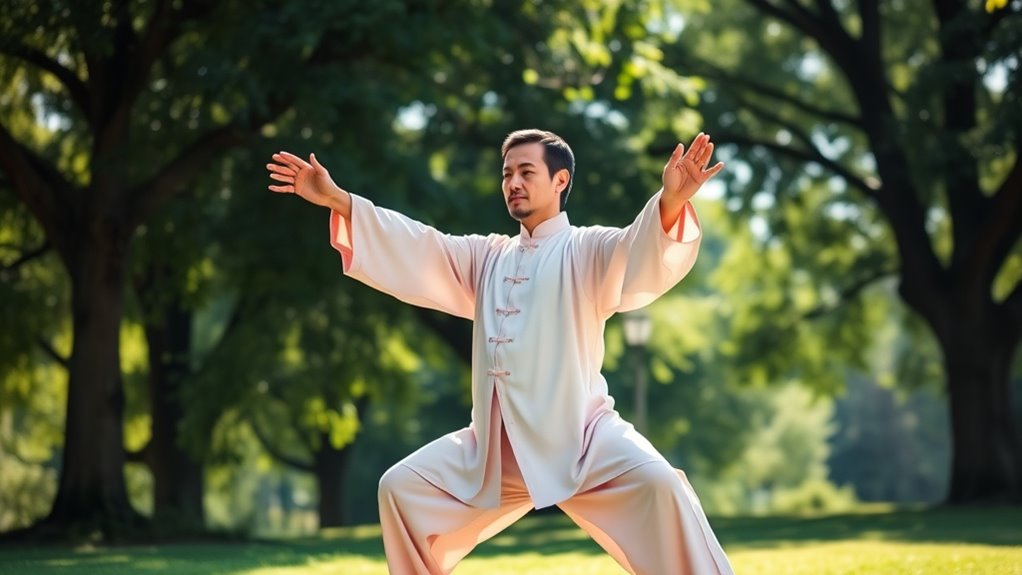
Connecting your breath with movement is essential in Tai Chi, as it helps cultivate a sense of flow and inner calm. To do this, focus on developing breath awareness, paying close attention to how your breath naturally deepens and smooths with each movement. Synchronizing your breath with your motions enhances movement synchronization, making your practice more fluid and centered. As you inhale, imagine your energy rising; with each exhale, visualize it settling into your body. Keep your breathing slow and steady, aligning it seamlessly with each movement. This connection creates a rhythm that anchors your mind and body, fostering stability. Developing breath awareness allows you to deepen your practice and attain greater tranquility. Incorporating mindful UV safety practices can prevent skin damage during outdoor practice, ensuring your health remains protected. Being mindful of proper technique can also improve your posture and overall effectiveness of practice. Over time, breath awareness and movement synchronization become second nature, allowing you to move with greater ease, calmness, and inner harmony.
Developing Mindfulness and Focus
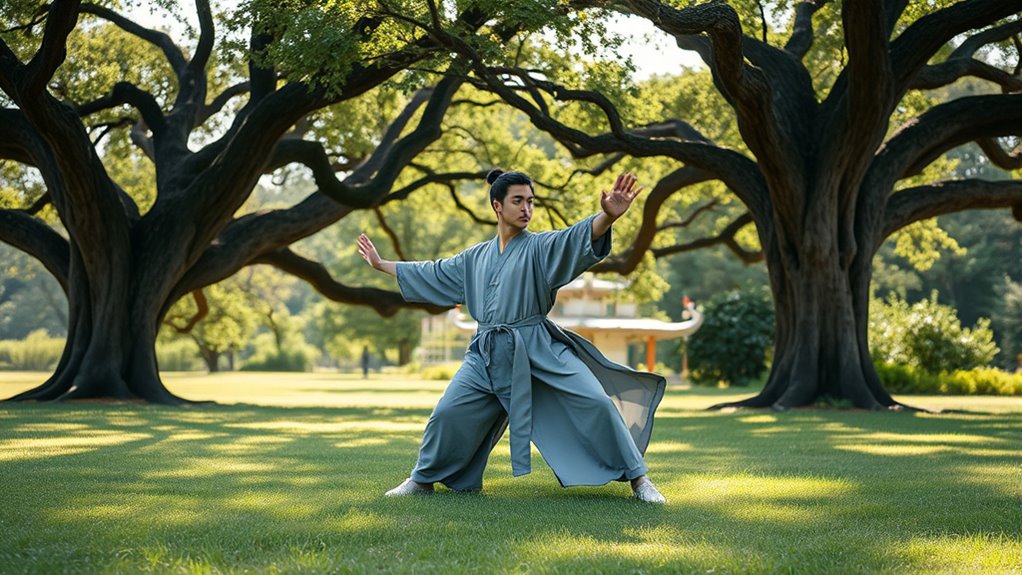
To deepen your Tai Chi practice, cultivating mindfulness and focus is essential, as it allows you to stay fully present in each movement and moment. Practice mindful observation by paying close attention to how your body feels, the placement of each limb, and your breathing. Focused attention helps you notice subtle shifts and alignments, preventing distraction. When performing each posture, resist the urge to multitask or think ahead; instead, gently bring your awareness back to the current moment. This sustained focus enhances your stability and calmness, creating a deeper connection between mind and body. Over time, mindful observation and focused attention become natural, enabling you to move with clarity, intention, and a sense of centered calm.
Balancing Energy Through Flowing Movements
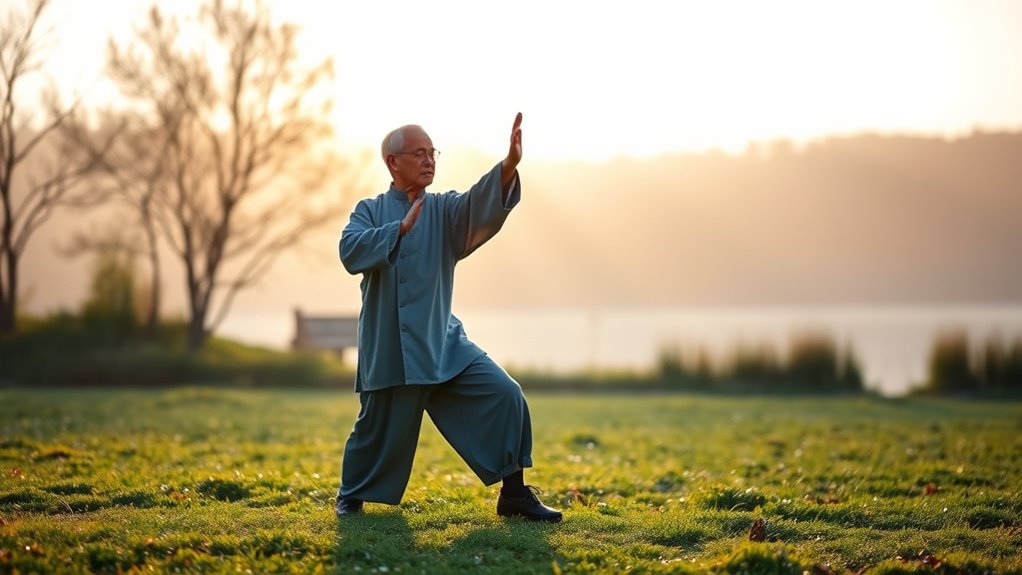
Flowing movements in Tai Chi serve as an essential method for balancing your energy, allowing it to circulate smoothly throughout your body. These movements help you develop a steady energy flow, preventing stagnation and promoting vitality. As you move fluidly, focus on coordinating your breath with each motion, enhancing the effectiveness of your balance exercises. The continuous, gentle progressions between postures activate your body’s natural energy channels, fostering calmness and stability. By practicing these flowing sequences regularly, you strengthen your ability to maintain equilibrium both physically and mentally. Remember, the key is to move with intention and awareness, letting your energy flow freely. This approach not only balances your energy but also cultivates a deep sense of calm and centeredness.
Common Mistakes and How to Avoid Them
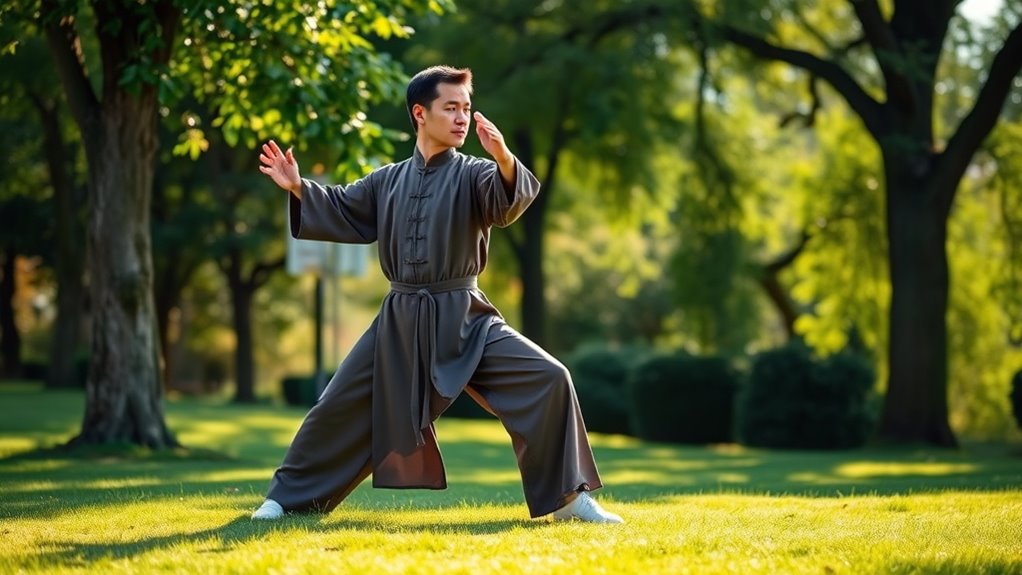
Even experienced practitioners can fall into common mistakes that hinder their Tai Chi progress. One of the most frequent errors is adopting an incorrect stance, which can throw off your balance and reduce stability. Focus on maintaining a grounded, relaxed posture that aligns your body properly. Another mistake is rushing through movements; Tai Chi emphasizes slow, deliberate motion to cultivate calmness and control. Rushed movements often lead to tension and reduce the flow of energy. To avoid these pitfalls, pay close attention to your stance and slow down your practice. Take the time to feel each movement fully and stay mindful of your body’s alignment. Consistent awareness helps develop better habits, ensuring your practice remains effective and contributes to greater stability and calm.
Incorporating Tai Chi Into Daily Life
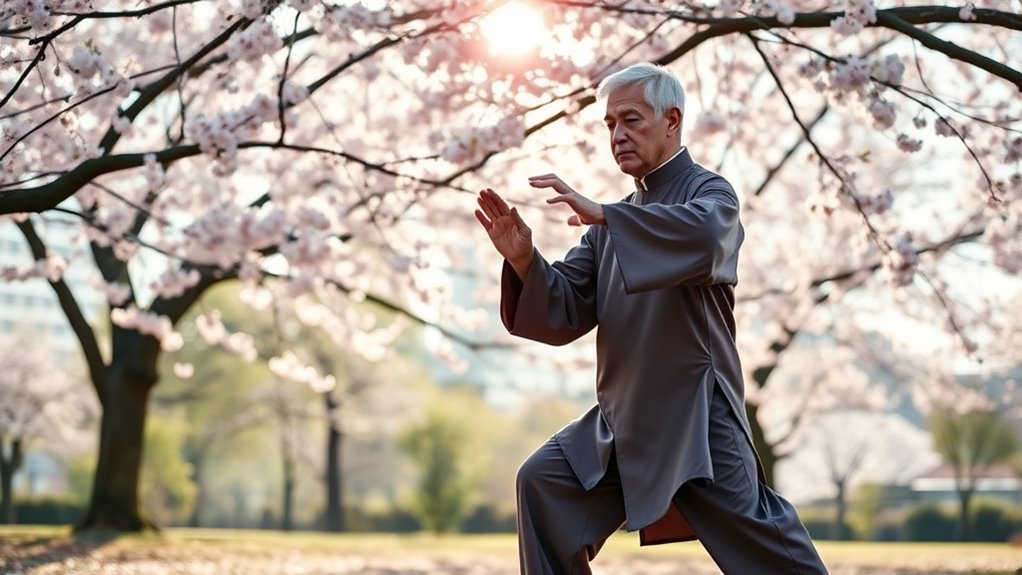
You can easily weave Tai Chi into your daily routine with simple practices. Starting your day with a morning routine, taking movement breaks at work, or relaxing in the evening can make a big difference. These small steps help you stay grounded and energized throughout the day.
Morning Practice Routines
Incorporating Tai Chi into your morning routine can set a positive tone for the entire day. Start with simple steps to integrate breath awareness and posture alignment. Here are four ways to do this:
- Begin with standing meditation, focusing on slow, deep breaths to center yourself.
- Practice gentle warm-up movements, paying attention to maintaining proper posture alignment.
- Incorporate slow Tai Chi forms, coordinating breath with movement for calmness.
- End with a short moment of stillness, observing your breath and ensuring your posture feels balanced.
Workplace Movement Breaks
Bringing mindful movement into your workday helps maintain energy and reduce stress. During short breaks, incorporate simple Tai Chi movements to rejuvenate your focus. Pay attention to office ergonomics and your workstation setup to guarantee proper posture. Stand up, stretch your arms, and gently rotate your shoulders to loosen tension. Incorporate slow, flowing movements like shifting your weight from one leg to another or gentle waist twists, which can be done right at your desk. These breaks help prevent stiffness and improve circulation. Keep your movements deliberate and relaxed, focusing on your breath. Regularly integrating these brief Tai Chi-inspired exercises into your routine promotes stability, calmness, and overall well-being throughout your busy workday.
Evening Relaxation Techniques
Evening is the perfect time to unwind and prepare your body for restful sleep by practicing gentle Tai Chi techniques. These exercises help reduce stress and improve sleep quality. To incorporate Tai Chi into your evening routine, try:
- Deep Breathing – Focus on slow, diaphragmatic breaths to calm your mind.
- Gentle Movements – Perform flowing, low-impact motions to release tension.
- Mindfulness – Pay attention to your body’s sensations, promoting relaxation.
- Stretching – Gentle stretches loosen tight muscles, easing stress and preparing you for rest.
Practicing these techniques nightly can create a calming *shift* from your busy day to restful sleep. Consistent evening Tai Chi fosters stress reduction and enhances sleep quality, helping you wake refreshed.
Frequently Asked Questions
Can Beginners See Immediate Benefits From Practicing Tai Chi?
You might wonder if beginners see instant relief or mental clarity from practicing Tai Chi. While it varies, many notice subtle improvements quickly, like feeling more relaxed and centered. With consistent practice, you’ll likely experience increased stability and calmness over time. Although immediate benefits are possible, patience helps you fully uncover Tai Chi’s calming effects and mental clarity, making your journey more rewarding and transformative.
How Long Does It Take to Master Basic Tai Chi Movements?
Imagine you practice basic Tai Chi movements three times a week; with consistent effort, you’ll notice progress within a few weeks. Mastery varies, but with practice consistency and patience development, most beginners gain fluency in fundamental postures in about three to six months. Keep practicing regularly, stay patient, and you’ll steadily improve your technique, making the movements feel more natural and effortless over time.
Is Tai Chi Suitable for All Age Groups and Physical Conditions?
Tai Chi is highly adaptable for all age groups and physical conditions. You can modify movements to suit your age adaptability and physical limitations, making it accessible whether you’re young or elderly. Its gentle, low-impact nature helps improve balance, flexibility, and strength without straining your body. So, regardless of your age or physical challenges, you can benefit from practicing Tai Chi and enjoy its calming, health-boosting effects.
What Equipment or Space Is Needed to Practice Tai Chi Effectively?
To practice tai chi effectively, you need a comfortable practice space that’s quiet and free of distractions, ideally about 6 to 8 feet square. No special equipment is necessary; just wear loose, comfortable clothing and flat shoes with good grip. You might also use a mirror to check your posture or a mat for added cushioning. Focus on creating a calm environment that allows you to move freely and concentrate on your form.
How Does Tai Chi Compare to Other Forms of Meditation or Exercise?
You might find that tai chi gently blends mindfulness integration with movement, offering a unique balance of physical and mental focus. Unlike other meditation forms that emphasize stillness, tai chi involves flowing motions, making it a graceful exercise that calms the mind while engaging the body. This dynamic approach helps you cultivate inner peace and stability, often making it more engaging and accessible than static meditation or intense workouts.
Conclusion
As you flow through tai chi’s gentle movements, imagine your energy like a calm river, smoothly weaving through obstacles. Each breath anchors you in the present, bringing serenity and strength. With consistent practice, you’ll feel your stability grow, like a sturdy tree rooted deep in the earth. Embrace these fundamentals daily, and watch your mind settle like still water, radiating calm and balance from within.










